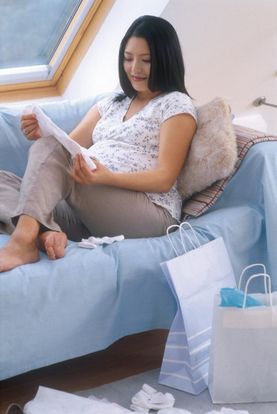28 weeks and 4 days pregn ...
28 weeks and 4 days pregnant

The sleep–wake cycle is now more established, however just because your baby is moving you cannot assume that he is awake. He spends little time fully active with his eyes open, so many of the movements you are feeling are happening while he is asleep.
Your baby’s growth depends on many factors and its rate varies through the course of your pregnancy.
The growth of your baby relies on a steady stream of nutrients. Most nutrients are transferred unaltered across the placenta, but some substances are made by the placenta itself and a few are produced from scratch by your baby. These include the hormone thyroxine, the production of which depends on iodine from the mother crossing the placenta. Thyroxine has several functions and its level needs to be controlled very precisely. The placenta forms a near-perfect barrier to thyroxine, enabling you and your baby to adjust thyroxine levels independently of each other.
More Similar Blogs
In the early stages of pregnancy, genetic factors largely determined the size of your baby, but by now environmental factors are becoming more important. Overall, your baby’s final birthweight is determined about 40 per cent by genetic factors and 60 per cent by environmental factors. Your baby grows at a steady rate from 24 weeks until the last 2–3 weeks, when growth continues but more slowly. (If you’re expecting twins, your babies grow as if alone in the uterus up until 28 weeks but from this point there is a reduction in their growth rate.) Your baby’s internal organs account for much of his current growth.The liver and brain, in particular, continue to enlarge and muscle mass increases. Later, fat will be deposited under the skin, rounding out your baby’s contours.
The incidence of identical twins has been stable for some years.
Identical twins represent about a third of all twin pregnancies, regardless of race, maternal age, or geography.
The clothes you buy for your twins should be easy to put on and take off, and, of course, machine washable. You’ll probably be given outfits as presents, so just buy the basics.
For each baby, you’re likely to need at least:
Six vests
Six babygros
Two jackets
One or two hats (sunhat for summer)
Several muslin cloths and bibs.
Keep in mind when choosing nappies that twins are often smaller on arrival than a single baby, and you may therefore get through a wide range of sizes in the first few months.
It’s advisable to buy a good-quality double buggy, as it will be used for quite a while. When choosing a buggy, a side-by-side model is preferable to a tandem buggy, so that your babies can see each other and communicate as they grow older.

Be the first to support
Be the first to share
Comment (0)




